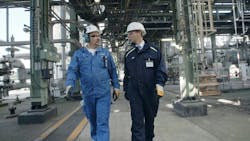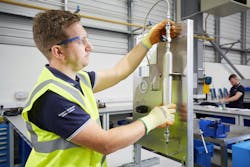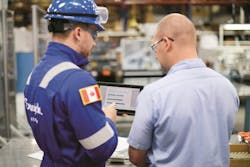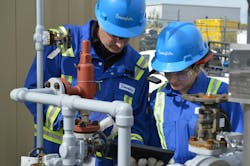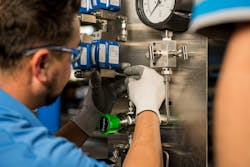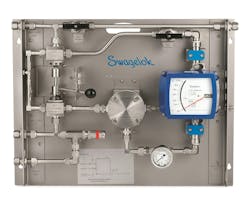Best practices to make plant turnarounds more effective and efficient
Turning a plant around is not an effort undertaken lightly. It is complex and frequently includes working with hundreds of technicians from multiple vendors. Coordinating those vendors to provide plant maintenance, restructuring and renewal tasks can feel overwhelming, whether they are focusing on one particular system or the whole plant.
Additionally, most plant turnarounds require taking some plant processes offline, which stops production and idles employees. Keeping turnarounds efficient also means lowering overall contractor costs because personnel will not be on-site for as long. For larger plants, it can take years of planning to ensure a turnaround goes smoothly, with turnaround-related activities often representing most of a facility’s annual maintenance budget. It is important not to mismanage the process and incur avoidable expenses.
Fortunately, there are seven best practices to help ensure a plant turnaround is managed efficiently and effectively.
1. Engage early with trusted suppliers
Avoiding potential pitfalls requires extensive planning that can often take years, prior to implementing a turnaround project. In the planning process, engaging early and often with trusted service providers can make the difference between a successful and unsuccessful venture.
The complexity of a facility’s major fluid systems often goes unnoticed if they are working properly. However, during a plant turnaround that complexity comes to the forefront. Fluid systems often require specialized parts and components built with specific alloys, which allow them to stand up to the rigors of particular applications. Procuring specialized components often means taking longer lead times into account, but by discussing needs with a supplier early enough in the process, unique component requests can be incorporated into the overall project timeline.
2. Identify areas of new opportunity
Beyond lead times, engaging early with trusted vendors also allows for modifications to systems that can help them operate more reliably. Strategic partners can often see inefficiencies in systems that plants may not be aware of.
Improvements do not occur without significant advanced planning. When a decision is made to change systems, those choices often require advance approval before the turnaround starts due to management of change (MOC) requirements. Additionally, engineers may institute a freeze after which changes cannot be made, so making sure these decisions are made well in advance is crucial.
One potential area that could enhance a system is choosing preengineered and preassembled grab sampling panels. By replacing traditional site-constructed grab sampling systems, an assembled panel reduces the chance for user errors when samples are pulled without fundamentally altering the system design. Additionally, operators may decide to take the opportunity to upgrade valves to low-E versions instead of merely replacing current components with potentially outdated valve designs. Turnarounds are a great time to make these improvements.
3. Prepare for the unexpected
No plant turnaround will occur without some unforeseen circumstances cropping up. Exploring these possible variables and contingencies and planning for them is another essential way to improve overall project efficiency.
For example, it may be impossible to know the exact number of parts and components necessary to complete a full plant turnaround because of the complexity of most industrial fluid systems. To account for this variability, teams should discuss how to stock a variety of hoses, valves and adapters with suppliers so they will be ready for use at a moment’s notice. This discussion should occur long before the project starts. Stockpiling common components can save significant time and money, rather than waiting to order components in the middle of the installation and experiencing delays.
That said, it does not make financial sense to stock so many components that it leads to unused inventory when the project is done. Reputable suppliers will allow temporary stock or consignment inventory, so the parts are always only a phone call away. Under this system, plants only pay for the parts they use. Such agreements can also mitigate supply chain issues associated with natural disasters, pandemics and other events beyond the operator’s control.
4. Ensure the availability of local support
Choose vendors to partner with that can offer localized support close to the plant so they can source unanticipated part needs quickly and efficiently. Reliable vendors should also be available to come on-site to help install systems correctly.
5. Keep an eye on the installation of critical parts
On projects as large as the average plant turnaround, there may be hundreds of different technicians working at a facility at any given time. They will come from different firms and disciplines and may even come from other countries.
Managing a diverse workforce can be challenging because the levels of installation knowledge may differ significantly from vendor to vendor. It also creates the possibility of inconsistencies in installation practices, which cannot take place on a turnaround project. Experienced technicians will have insights into particular plant functions that other less-experienced technicians may not. They will understand the optimal way to route tubes to eliminate vibration damage over time. They will also know which tools are necessary to do an installation properly, preventing unnecessary damage to components that might affect performance down the road.
The goal, then, is to ensure the technicians working on the turnaround are as experienced as possible. Incorporating specific training and certification requirements — such as the JIP 33/IOGP specifications that require certified training by the manufacturer — into the solicitation process ensures standards are met across the board. It will help eliminate the inexperienced technicians and vendors who might slow down progress on the turnaround and provide some security in the fact that the job will be done in accordance with industry best practices. It also ensures technicians are well trained before the work begins.
6. Seek out prefabricated assemblies
Another method to help reduce installation errors from occurring is to specify as many prefabricated, preassembled and pretested systems as possible before the turnaround. Contractors will have fewer moving parts to install and test, which can streamline installation and make it easier for technicians.
Using prefabricated assemblies also allows for potential expertise and knowledge deficiencies between different vendors and contractors, while saving money on labor at the same time. As discussed earlier, installing grab sampling panels is one area where prefabricated components are common. Additionally, using mechanical seal support systems improves the life span of most mechanical seals. Analytical subsystems, including fast loops, field stations, calibration and switching modules, sample probes and fluid distribution headers, can also bring efficiency and consistency to operations with simplified design footprints.
7. Maintain tight quality control
Finally, controlling the quality of the parts and components can mean the difference between a successful turnaround and an unsuccessful one. Specify with precision so contractors cannot default to less expensive and lower-quality components. Once vendors introduce inconsistent quality into an industrial fluid system, poor performance typically follows. Poor quality components can fail prematurely and drive higher, unnecessary maintenance costs. Stay up to date on the standards for fluid system design and specify the project accordingly. Do not allow contractors to intermix and interchange parts between suppliers, which can not only negatively affect performance but can also complicate maintenance down the road.
Why this matters
Following these seven practices from the planning to the execution of a plant turnaround will smooth out the process. The turnaround will be more efficient and effective and lead to better performance and reliability of fluid systems over time. Component suppliers should be able to serve as a guide through the process to make sure the next turnaround will be as successful as possible.
An original version of this article appeared on the Swagelok Reference Point blog here.
Mike Aughenbaugh is an associate target market manager for Swagelok Company.
About the Author
Mike Aughenbaugh
Associate target market manager for Swagelok Company.
Mike Aughenbaugh is an associate target market manager for Swagelok Company.
